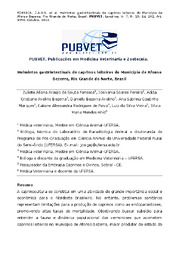Helmintos gastrintestinais de caprinos leiteiros do Município de Afonso Bezerra, Rio Grande do Norte, Brasil.
Helmintos gastrintestinais de caprinos leiteiros do Município de Afonso Bezerra, Rio Grande do Norte, Brasil.
Author(s): FONSECA, Z. A. A. de S.; PEREIRA, J. S.; BEZERRA, A. C. A.; AVELINO, D. B.; MARQUES, A. S. C.; PAIVA, K. A. R. de; VIEIRA, L. da S.; AHID, S. M. M.
Summary: Resumo: A caprinocultura se constitui em uma atividade de grande importância social e econômica para o Nordeste brasileiro. No entanto, problemas sanitários representam limitações para a produção de caprinos como as endoparasitoses, promovendo altas taxas de mortalidade. Objetivando buscar subsídio para entender a fauna e dinâmica populacional das verminoses que acometem caprinos leiteiros no município de Afonso Bezerra, maior produtor do estado do Rio Grande do Norte, foi realizado um levantamento epidemiológico de helmintos gastrintestinais com utilização de traçadores. Utilizaram-se caprinos traçadores submetidos previamente a condições ambientais naturais da região, sendo seu conteúdo gástrico recuperado e enviado para análise, identificação e contagem dos exemplares encontrados. Os resultados demonstraram que a dinâmica populacional das helmintoses sofre influência direta de fatores climáticos, sendo os helmintos encontrados em ordem de prevalência Haemonchus contortus (57,23%), Trichostrongylus colubriformis (40,54%), Oesophagostomum columbianum (1,42%), Trichuris globulosa (0,46%), Trichostrongylus axei (0,19%), Moniezia expansa (0,15%) e Strongyloides papillosus (0,1%). Abstract: The goat constitutes an activity of great social and economic importance to the Brazilian Northeast. However, health problems represent limitations on the production of goats as endoparasitoses, promoting high mortality rates. Aiming to seek grant for understanding population dynamics and fauna of worms that affect dairy goats in the municipality of Afonso Bezerra, the largest producer in the state of Rio Grande do Norte, an epidemiological survey was conducted of gastrointestinal helminths using tracers. We used tracer goats previously submitted to natural environmental conditions of the region, and its stomach contents recovered and sent for analysis, identification and counting of specimens found. The results showed that the population dynamics of helminth suffers direct influence of climatic factors, and the helminths found in order of prevalence Haemonchus contortus (57.23%), Trichostrongylus colubriformis (40.54%), Oesophagostomum columbianum (1.42%), Trichuris globulosa (0.46%), Trichostrongylus axei (0.19%), Moniezia expansa (0.15%) and Strongyloides papillosus (0.1%).
Publication year: 2013
Types of publication: Journal article
Unit: Embrapa Goats & Sheep
Keywords: Animal disease, Caprino, Doença animal, Endoparasites, Epidemiologia, Epidemiology, Goats, Haemonchus contortus, Helminths, Helminto gastrintestinal, Moniezia expansa, Nematode infections, Nematódeo gastrintrestinal, Nematóide, Oesophagostomum columbianum, Parasites, Strongyloides papillosus, Transmissão de doença, Trichostrongylus axei, Trichostrongylus colubriformis, Trichuris globulosa
Observation
Some of Embrapa's publications are published as ePub files. To read them, use or download one of the following free software options to your computer or mobile device. Android: Google Play Books; IOS: iBooks; Windows and Linux: Calibre.
Access other publications
Access the Agricultural Research Database (BDPA) to consult Embrapa's full library collection and records.
Visit Embrapa Bookstore to purchase books and other publications sold by Embrapa.

